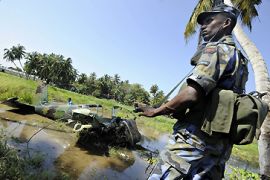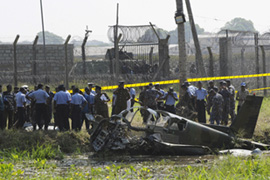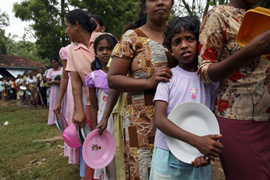‘High cost’ of victory over Tigers
Rebel movement is on its last legs but the government’s victory comes at a high price.

 |
| The Tamil Tigers’ air attack on Colombo is unlikely to herald a return to fortune for them [Reuters] |
It will be tempting to assume that the audacious air raid on Colombo by the Tamil Tigers signals the start of a dramatic revival of Sri Lanka’s deadly separatist group after a string of losses.
But the bombing, in the centre of Colombo, Sri Lanka’s largest city, which killed two people and wounded another 50, will not derail the military’s relentless and ruthless push into rebel territory.
With just 100sq km of mostly rugged terrain still under its control, the Liberation Tigers of Tamil Eelam (LTTE) can expect only bleaker times as weeks and months roll by.
How all this happened is a remarkable story.
| Focus: Sri Lanka | ||||||

| ||||||
Seven years ago, the LTTE was on top, having scored spectacular military victories that forced Colombo to seek out a Norwegian-brokered ceasefire with the Tigers.
That was in February 2002, when Velupillai Prabhakaran, the LTTE founder and leader, was the undeclared king of Sri Lanka’s north and east.
Many Tamils argue today that Prabhakaran, now 55, should have used the favourable times to graduate from a military leader to a politician, for the sake of the Tamil community.
The safari suit that Prabhakaran traded for his military fatigues in order to address journalists in the northern town of Kilinochchi in April 2002 – his last press conference – gave an impression that he was ready to make a change.
But that did not happen – and with disastrous consequences.
Intransigence
As Colombo and the LTTE met around the world for six rounds of seemingly promising peace talks, Prabhakaran remained adamant that he would settle for nothing less than an independent state for the Tamils.
This amounted to political hara-kiri.
Ever since he stepped into the world of militancy as a young man in the 1970s, opportunity and luck helped Prabhakaran gain stature.
But by 2004, the good fortune appeared to be deserting him.
In March that year, Karuna, one of his closest lieutenants who commanded the entire eastern region of Sri Lanka for the LTTE, broke away with thousands of fighters to create a deep chasm in the otherwise regimented outfit.
 |
| Thousands of soldiers have been killed in the campaign Rajapaksa launched in 2006 [AFP] |
Two months later, neighbouring India elected the Congress party, bringing to power the Italian-born Sonia Gandhi, who Prabhakaran had widowed in 1991 when he ordered the suicide bombing of Rajiv Gandhi, her husband and former Indian prime minister.
No one realised then how the change in government in New Delhi would one day prove detrimental to the LTTE.
Prabhakaran refused to compromise, continued his use of assassinations to further his cause and moved to turn the LTTE territory in parts of the island’s northeast into a de-facto state.
Lost efficacy
This undid the peace process, isolated its broker Norway (which many Sinhalese said was biased towards the LTTE), weakened the government that had signed a peace deal with him and eventually turned many countries against the rebel leader.
In the process, the LTTE’s arguments about Colombo’s political insincerity, some of them valid, lost efficacy.
The cold-blooded killing of Lakshman Kadirgamar, Sri Lanka’s foreign minister, in August 2005 by a LTTE sniper, was a turning point.
Prabhakaran also told Tamils to boycott the presidential election in November 2005, thus ensuring the victory of Mahinda Rajapaksa, who has become the LTTE’s nemesis.
Prabhakaran’s reasoning was that a Sinhalese hardliner would help widen the ethnic divide and further the separatist drive.
Even Tamils sympathetic to the LTTE admit that the boycott decision was his biggest political blunder after the Gandhi assassination.
 |
| Aid agencies say 230,000 civilians, mostly ethnic Tamils, are trapped in Mullaitivu [AFP] |
Within a month of Rajapaksa’s victory, Prabhakaran began provoking the military, which by then had teamed up with the breakaway LTTE leader Karuna.
In April 2006, a female LTTE suicide bomber almost blew up Sri Lanka’s army chief, Sarath Fonseka, leaving him badly wounded.
He returned to his post with a vengeance.
Within months, the LTTE tried to assassinate Gotabaya Rajapaksa, the president’s brother and the spearhead of Colombo’s war against the Tigers. He also survived.
The end result was a hardened Sri Lanka, which decided to formally ditch the Norway-brokered peace process and go for the kill.
Provocations
LTTE’s provocations sparked off a full-scale war in 2006 that the Tigers initially thought they would be able to win.
But luck was no longer with the man who had chased the dream of an independent Tamil state from his teenage years.
With crucial support from Karuna, the military won control of the entire eastern province in 2007 – after more than a decade.
The military went on the offensive in the north in 2008, spectacularly capturing territory after territory the Tigers had lorded over for 10 years and shattered the myth of LTTE’s invincibility.
By the end of the year, Prabhakaran was on the run.
But the LTTE is not finished. It is down, but not out. Not yet.
Friday’s bombing of Colombo by the LTTE air wing – it is the world’s only insurgent group with planes – only proves that the Tigers will never give up.
Prabhakaran still has hundreds of guerrilla fighters, although cornered in a mainly forested region of the northern Mullaitivu district. While many are perhaps as fanatical as their chief, there are a significant number of child recruits.
No resurgence
It is apparent that the LTTE will never be able to bounce back to its golden days when it lorded over a large swath of land, commanding a state within a state.
| In video |
|
|
The military has made too many gains and seized massive quantities of arsenal, dealing crippling blows the LTTE will find it near impossible to recover from.
The global crackdown on the Tigers has also aided Colombo. It is now classified as a “terror group” in about 30 countries.
Even Norway has told the Tigers to sue for peace.
India, a key player in Sri Lanka, has gone to the extent of saying that LTTE has damaged the Tamil community and it should give up its weapons.
The LTTE does not have much of a choice.
Street protests by a section of political parties in India’s Tamil Nadu state have not influenced New Delhi to lean on Colombo in support of a ceasefire, that most analysts feel would give breathing time to the gasping Tigers.
Sri Lanka is in no mood for any further talks with the LTTE and nor is it ready to halt its military onslaught.
So the LTTE will fight on with all its might.
In the process, the worst sufferers will be the mass of Tamil civilians still caught up in the war zone.
M.R. Narayan Swamy is Deputy Editor at IANS news agency based in New Delhi. He is the author of two books on the Tamil separatist fighting and writes regularly on Sri Lanka.
The views expressed by the author are not necessarily those of Al Jazeera.

